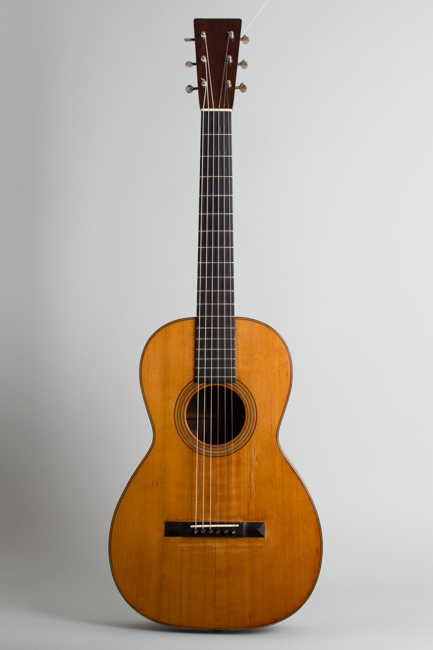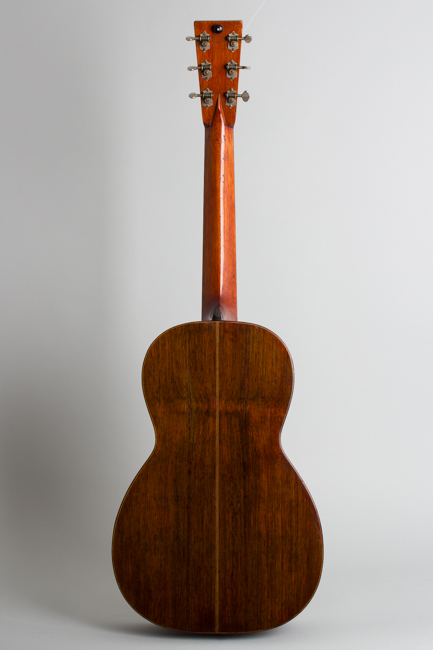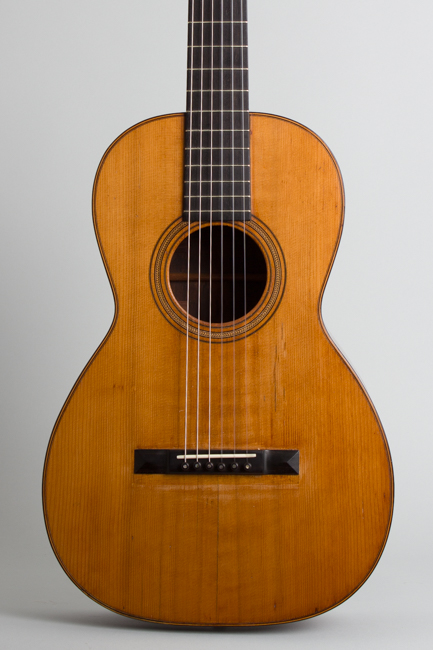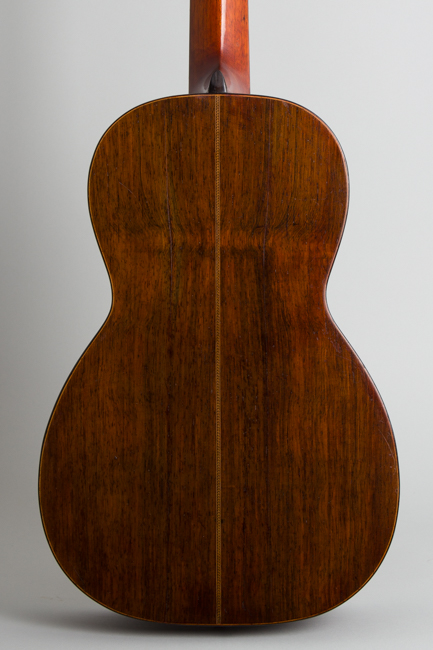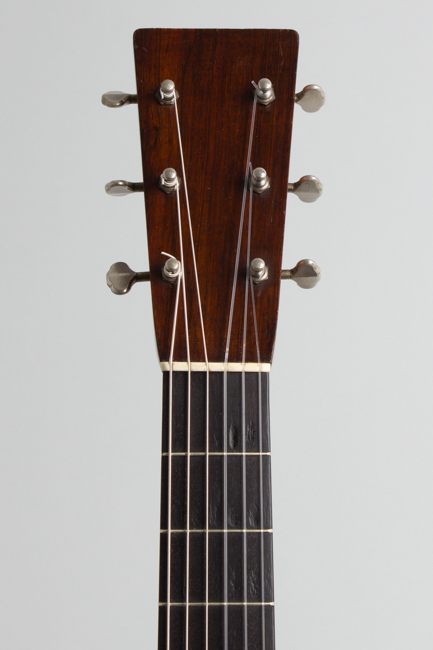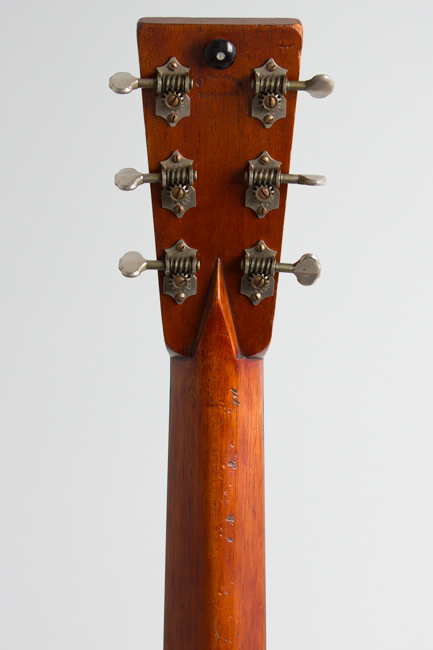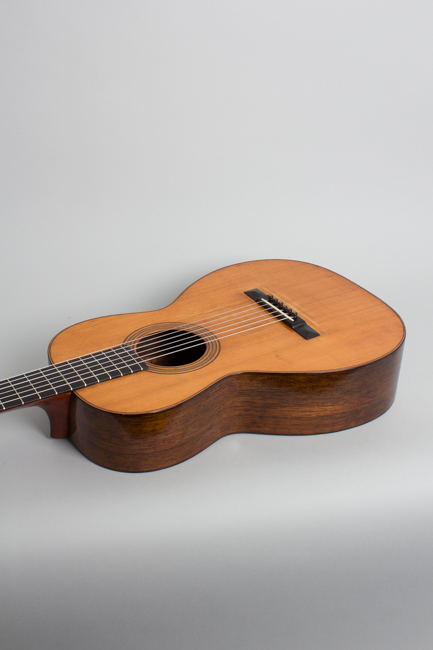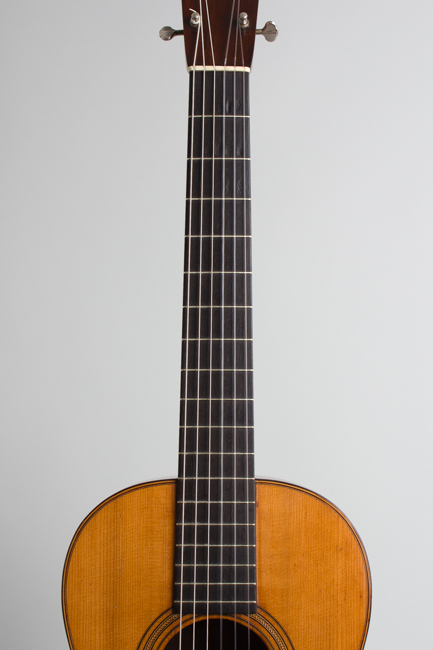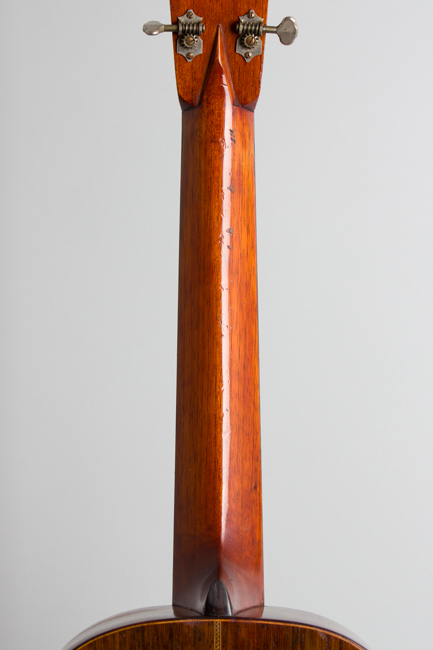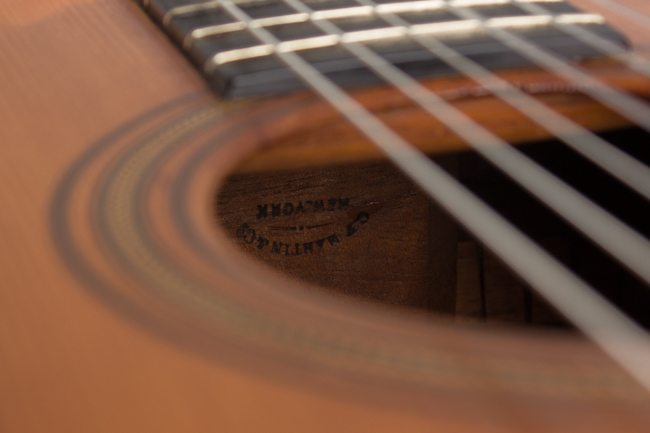C. F. Martin 1-21 Flat Top Acoustic Guitar (1889)
This item is currently on hold.
Item # 12353
Prices subject to change without notice.
C. F. Martin 1-21 Model Flat Top Acoustic Guitar (1889), made in Nazareth, PA, natural finish, Brazilian rosewood back and sides, spruce top; cedar neck with ebony fingerboard, black hard shell case.
This is fine playing and sounding 19th century Martin Style 1-21, showing some old repair and minor modification but still a lovely instrument. The 1-21 is one of the company's more venerable styles dating all the way back to the 1850s. It was considered an affordable midline model and remained fairly popular through the latter part of the 19th century. Although the under-13" size "1" is considered a very small guitar today, before 1854 it was the largest size Martin made.
The Style 21 is primarily distinguished by its herringbone soundhole rosette, with plain wood trim around the body edge. The now more famous Style 28 is trimmed along the top with herringbone, and for much of the 20th century the 21 was seen as sort of a second choice, the cheapest rosewood guitar Martin offered. That was not the case when this one was built around 1880; Martin's line was more extensive and the 21 sat solidly in the middle.
Martins from this period have no serial numbers but often show visible internal dating marks. There is some fairly faint pencil script under the top of this one that appears to read 10-89, which wound indicate fabrication in October 1889, when Benjamin Harrison was president. The rosewood body has some lovely figure, especially on the back. The red spruce top is very delicately braced with the traditional scalloped X pattern. The soundhole shows the trademark Style 21 herringbone inset, and all bindings and trim are wood.
The cedar neck has a fairly shallow soft "V" profile, topped with a plain unmarked ebony fingerboard fitted with the traditional Martin bar frets. This guitar was built in the rarer "Peg Head" configuration, with a solid headstock originally fitted with violin-style friction pegs instead of machines. In the 19th century some players preferred that in those gut-string days. The old "C.F. Martin, New York" stamp is visible on the back of the headstock under the tassel-cord strap button. The newer "C.F. Martin & Co. New York" logo is stamped into the backstrip and the heelblock, where it was applied upside down!
With close to 135 years under it's belt, this little rosewood guitar has seen a lot of use. It shows a decent amount of wear and repair but escaped the often catastrophic damage caused when old Martins were often steel-strung starting in the 1920s. This beautifully made and delicately X-braced guitar (like all Martins from this era) is suited to gut or nylon strings ONLY. It is a lovely and stately guitar that wears its scars proudly and still sings beautifully with a robust and surprisingly powerful sound.
Overall length is 38 in. (96.5 cm.), 12 7/8 in. (32.7 cm.) wide at lower bout, and 4 1/4 in. (10.8 cm.) in depth at side, taken at the end block. Scale length is 24 3/4 in. (629 mm.). Width of nut is 1 13/16 in. (46 mm.).
This charming nearly century-and-a-half old guitar shows many scars but is still a lovely player, a real testament to the craftsmanship that has always been the hallmark of the C.F Martin & Co. organization. The guitar has seen a number of typical repairs, and the lovely if somewhat impractical (to modern players anyway) friction pegs were long ago replaced with old Grover Sta-tite machines.
The finish is a bit of a mixed bag; the neck and headstock are unaltered original varnish, with dings and dents but not an excessive amount of wear especially considering its age. There is a spotty overfinish to the heel only, and a very neatly repaired split through the heel is visible on close inspection. The body shows a VERY old and thin lacquer overfinish, probably done 75 or more years ago. This is most noticeable on the top, where a larger bridge was once mounted and then removed, leaving a visible scar that was more recently patched up. The bridge on the guitar now is a very nicely done repro of the ebony original. The top shows less "strum wear" than most, but has a slightly uneven look due to the finish over some wear spots. There are a number of nicks, dings and scrapes scattered over the instrument, some under and many over the overfinish.
The top shows two spruce grain splits below the bridge, above the center seam that was also resealed running to the back edge. These are solidly sealed but visible. The back has two long grain splits to the rosewood running its entire length which are almost perfectly mirrored; the seem to be centered along a weak spot in the bookmatched grain. There are very neatly cleated with cross-grain wood blocks along their entire length. Another small repaired split lies between them. The sides also have a few inconspicuous grain splits; most of these top and side repairs are re-inforced with the older fabric-and-glue formula.
The guitar has had the neck reset, fairly neatly but with a small chip off the heel on the bass side and the aforementioned heel split. The original bar frets have been leveled but are still intact. Internally the tiny original bridge plate and delicate scalloped bracing remain intact. This venerable Martin is an excellent player with nylon strings and a wonderful trip back to the 19th century, an authentic playable museum piece and simply a delightful featherweight guitar. It lives in a well fitted modern HSC. Overall Very Good Condition.
This is fine playing and sounding 19th century Martin Style 1-21, showing some old repair and minor modification but still a lovely instrument. The 1-21 is one of the company's more venerable styles dating all the way back to the 1850s. It was considered an affordable midline model and remained fairly popular through the latter part of the 19th century. Although the under-13" size "1" is considered a very small guitar today, before 1854 it was the largest size Martin made.
The Style 21 is primarily distinguished by its herringbone soundhole rosette, with plain wood trim around the body edge. The now more famous Style 28 is trimmed along the top with herringbone, and for much of the 20th century the 21 was seen as sort of a second choice, the cheapest rosewood guitar Martin offered. That was not the case when this one was built around 1880; Martin's line was more extensive and the 21 sat solidly in the middle.
Martins from this period have no serial numbers but often show visible internal dating marks. There is some fairly faint pencil script under the top of this one that appears to read 10-89, which wound indicate fabrication in October 1889, when Benjamin Harrison was president. The rosewood body has some lovely figure, especially on the back. The red spruce top is very delicately braced with the traditional scalloped X pattern. The soundhole shows the trademark Style 21 herringbone inset, and all bindings and trim are wood.
The cedar neck has a fairly shallow soft "V" profile, topped with a plain unmarked ebony fingerboard fitted with the traditional Martin bar frets. This guitar was built in the rarer "Peg Head" configuration, with a solid headstock originally fitted with violin-style friction pegs instead of machines. In the 19th century some players preferred that in those gut-string days. The old "C.F. Martin, New York" stamp is visible on the back of the headstock under the tassel-cord strap button. The newer "C.F. Martin & Co. New York" logo is stamped into the backstrip and the heelblock, where it was applied upside down!
With close to 135 years under it's belt, this little rosewood guitar has seen a lot of use. It shows a decent amount of wear and repair but escaped the often catastrophic damage caused when old Martins were often steel-strung starting in the 1920s. This beautifully made and delicately X-braced guitar (like all Martins from this era) is suited to gut or nylon strings ONLY. It is a lovely and stately guitar that wears its scars proudly and still sings beautifully with a robust and surprisingly powerful sound.
Overall length is 38 in. (96.5 cm.), 12 7/8 in. (32.7 cm.) wide at lower bout, and 4 1/4 in. (10.8 cm.) in depth at side, taken at the end block. Scale length is 24 3/4 in. (629 mm.). Width of nut is 1 13/16 in. (46 mm.).
This charming nearly century-and-a-half old guitar shows many scars but is still a lovely player, a real testament to the craftsmanship that has always been the hallmark of the C.F Martin & Co. organization. The guitar has seen a number of typical repairs, and the lovely if somewhat impractical (to modern players anyway) friction pegs were long ago replaced with old Grover Sta-tite machines.
The finish is a bit of a mixed bag; the neck and headstock are unaltered original varnish, with dings and dents but not an excessive amount of wear especially considering its age. There is a spotty overfinish to the heel only, and a very neatly repaired split through the heel is visible on close inspection. The body shows a VERY old and thin lacquer overfinish, probably done 75 or more years ago. This is most noticeable on the top, where a larger bridge was once mounted and then removed, leaving a visible scar that was more recently patched up. The bridge on the guitar now is a very nicely done repro of the ebony original. The top shows less "strum wear" than most, but has a slightly uneven look due to the finish over some wear spots. There are a number of nicks, dings and scrapes scattered over the instrument, some under and many over the overfinish.
The top shows two spruce grain splits below the bridge, above the center seam that was also resealed running to the back edge. These are solidly sealed but visible. The back has two long grain splits to the rosewood running its entire length which are almost perfectly mirrored; the seem to be centered along a weak spot in the bookmatched grain. There are very neatly cleated with cross-grain wood blocks along their entire length. Another small repaired split lies between them. The sides also have a few inconspicuous grain splits; most of these top and side repairs are re-inforced with the older fabric-and-glue formula.
The guitar has had the neck reset, fairly neatly but with a small chip off the heel on the bass side and the aforementioned heel split. The original bar frets have been leveled but are still intact. Internally the tiny original bridge plate and delicate scalloped bracing remain intact. This venerable Martin is an excellent player with nylon strings and a wonderful trip back to the 19th century, an authentic playable museum piece and simply a delightful featherweight guitar. It lives in a well fitted modern HSC. Overall Very Good Condition.
